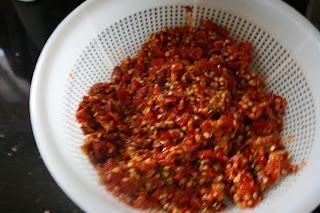Chilli Peppers in Brine
Peter Piper picked a peck of pickled peppers
A peck of pickled peppers Peter Piper picked.
If Peter Piper picked a peck of pickled peppers,
How many pickled peppers did Peter Piper pick?
I just love this nursery rhyme from childhood. The beautiful alliteration is quite catchy and repeating the rhyme is enough to make you smile, a big happy smile :D
Funnily enough my parents ate quite bland food. Fish or meat with 3 vegetables almost every night.
Both of my parents are steeped in English background. My mother is a descendent of Matthew Everingham who was on the First Fleet, so I often joked to my friends that we were brought up on bread and water.
Actually, it was more like Sunday roasts with baked vegetables or freshly caught fish with oven baked chips and salad. I vividly remember the first time I had garlic bread at a friends' house and marvelled at the amazing flavour. Chilli, not very hot, was enjoyed at the same friends Italian family restaurant and had such an impact on me.
I was mesmerised! These wonderful flavours had been hiding from me for all of my life.
Since then, my husband says that I am still making up for the lack of heat in my early years. I love chilli.
I love garlic and chilli, together or apart. If I have a sore throat the first thing I reach for is a spoonful of harissa or sriracha to numb my throat and kill the germs (it certainly makes me feel better anyway).
Hence, we grow chillies, of many shapes, sizes and heat strength.
To eat, puree, cook, dry, freeze, give away, jam or to bottle.
This is an easy recipe for bottling whole chillies and I hope you too have the pure enjoyment of chilli peppers.
Leave the chillies whole, wash them and leave some stem on, about 1cm if possible.
Bring salted water to the boil and blanch the chillies in batches, for 1 minute, then remove, place in a colander and refresh with cold water.
Sterilise your jars by placing clean jars into a cold oven, turning the oven to 150 degrees celsius and when it has reached temperature., turn the oven off and let sit for 10 minutes.
Put the lids into a jug of boiling water and let sit 5 minutes, then carefully remove with tongs.
Bring the vinegar to a simmer in a saucepan, adding the spices and stirring until the sugar is dissolved.
Take the sterilised jars from the oven with oven mitts, placing onto a tea towel on the bench so they don't crack on a cold surface. Place the whole chilli peppers in the jar, then pour the brine solution over the top completely immersing the chillies in liquid. You will find after 5 minutes that you need to add more brine as the air pockets in the chillies are filled with liquid. Put the hot jar lids on and seal, label and let sit for 1 month before consuming. This recipe will last for 2 years (if you don't eat them all first).
Pickled Chilli Peppers in Brine
600g fresh long chillies2 tablespoons sugar
2 Tablespoons salt
1 Tablespoon black mustard seeds
10 black peppercorns
4 bay leaves
500ml cider vinegar
500ml white vinegar
Extra salt for boiling water
Rinse chillies, leaving them whole, then boil for 1 minute. Remove and refresh in cold water.
Add all brine ingredients together and bring to a quick boil, stirring just until the sugar is dissolved.
Place chillies in hot sterilised jars, pour brine solution over until completely covered.
Seal and wait at least 1 month before consuming.
Buon appetito!
Add all brine ingredients together and bring to a quick boil, stirring just until the sugar is dissolved.
Place chillies in hot sterilised jars, pour brine solution over until completely covered.
Seal and wait at least 1 month before consuming.
Buon appetito!






























































